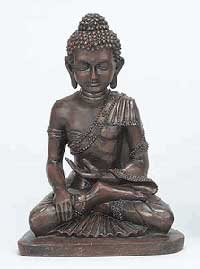The Logic of Religious Images
by David Curzon, Forward Newspaper Online, May 20, 2005
New York, USA -- Close to the end of this week's portion is the injunction (Leviticus 26:1), "You shall not make idols for yourselves." The Jewish Study Bible (Oxford University Press, 2004) annotates this by referring the reader back to an earlier verse (25:42) on the freeing of Hebrew slaves in the jubilee year, which is required because "they are My servants, whom I freed from the land of Egypt; they may not give themselves over into servitude." The use of religious images is to be understood, then, as a form of servitude.

<< The images of Buddhism function as supports for meditation
This ban on the making of images is of course to be associated with the second of the Ten Commandments (Exodus 20:4 and Deuteronomy 5:8), "You shall not make for yourself a sculptured image, any likeness of which is in the heavens above, or on the earth below, or in the waters below the earth." The ban also appears elsewhere, such as in Deuteronomy 4:15-18, where we are told, "since you saw no shape when the Lord your God spoke to you" on Sinai, do not "make for yourselves a sculptured image in any likeness whatever." In the JPS commentary on Deuteronomy, Jeffrey H. Tigay annotates this with the remark (pages 48-49) that idolatry "assumed that by a kind of sympathetic magic, like that connected with voodoo dolls, a being was somehow present in its representation."
This assumption that the followers of religions that make use of images think the image is the god pervades the prophetic polemics against the worship of sticks and stones. As Yehezkel Kaufmann, on page 13 of his vast work, translated and abridged by Moshe Greenberg as "The Religion of Israel: From Its Beginnings to the Babylonian Exile" (Schocken Books, 1972), remarks: "A great part of biblical literature is dedicated to the battle against idolatry, striving to expose its absurdity and discredit it in the eyes of believers. When this material is examined it appears... that the sole argument advanced against pagan religion is that it is a fetishistic worship of 'wood and stone.'"
A respect for other religions requires those of us brought up in an iconoclastic religious tradition to understand the logic of the religious use of images. The images of Buddhism and Hinduism, for example, function as supports for meditation. Hindu images not representing anything in nature, and so not violating the plain meaning of the Second Commandment, represent the notion that the divine has the attributes of both Mercy and Justice by an image with two faces, one benign and one stern; that the divine is omnipotent by an image with many arms; that the divine is omniscient by an image with four heads, pointing in the four cardinal directions.
There are contemporary secular images functioning as aids to contemplation, such as the representation of Justice as a woman who is blindfolded and holding a pair of scales in her hand. This is to remind us that the attributes of true justice are impartiality and fairness. I doubt if anyone looking at this image has ever thought that justice was actually a person who is blindfolded or that judges were actually blindfolded, let alone that the image was in any sense alive. As with the image of Justice, many-armed images of Hinduism and Buddhism also normally hold attributes in their hands representing aspects of the divine, or exhibit hand gestures (mudras) that are symbolic.
All this is perfectly compatible with the view that the subject of worship is not capable of representation. In fact, this view is normal in the early stages of the world's great religions. For more than 500 years after the death of Buddha, traditionally put at 480 BCE, there was no representation of him in human form. He was, instead, represented by a footprint, symbolizing the notion that he preached a Path. Hindu images with many arms and heads developed well over a thousand years after the highly philosophical discourses of the Upanishads.
Why would religions that initially did not make use of icons come to accept their use? Ananda K. Coomaraswamy, the great art historian and former curator of the department of Asiatic art in the Boston Museum of Fine Arts, in an essay on "The Nature of Buddhist Art" (Coomaraswamy, Selected Papers, volume 1, Princeton University Press, 1977, pages 154-155), puts the case for iconography clearly and strongly:
One is astounded at the multitude of those who advocate a "direct" approach to God.... It is only one who has attained to an immediate Gnosis that can afford to dispense with theology, ritual and imagery.
He upholds the spirit of the Second Commandment when he points out that an Indian religious image is devoid of any semblance of organic structure; it is not a reflection of anything that has been physically seen, but an intelligible form or formula.
He argues (page 163, footnote 26) that a symbol may be verbal or visual, but that "the use of material is inevitable." Both words and images are merely aids, and some form of aid is necessary because, as a Sufi aphorism in the Kitab al-Hikam observes, with an ironic acceptance of human limitations from within a religious tradition that rejects the use of images:
The form of the Formless depends on reception.


